Honor Magicbook 14 Notebook Review: Where Style Paints a Picasso
by Dr. Ian Cutress on May 15, 2020 9:00 AM EST- Posted in
- Laptops
- AMD
- Notebooks
- Zen
- honor
- Picasso
- MagicBook
- Magicbook 14
- Ryzen 5 3500U
Turbo, Power and Latency
Turbo
As part of our usual test suite, we run a set of code designed to measure the time taken for the processor to ramp up in frequency. Recently both AMD and Intel are promoting features new to their processors about how quickly they can go from an active idle state into a turbo state – where previously we were talking about significant fractions of a second, we are now down to milliseconds or individual frames. Managing how quickly the processor fires up to a turbo frequency is also down to the silicon design, with sufficient frequency domains needing to be initialized up without causing any localised voltage or power issues. Part of this is also down to the OEM implantation of how the system responds to requests for high performance.
For our Honor Magicbook and the Ryzen 5 3500U, we get a base frequency around 1200 MHz, and within 2 milliseconds the system shoots up to a fast 2750 MHz. This is not the final turbo, as it requires another 10 milliseconds going through several frequency stages to finally get to a 3.7 GHz turbo frequency. Overall, from idle, we measured just under 13 milliseconds, which coincides with a single frame at 60 Hz. This is usually the target for user-level responsiveness, so the Magicbook gets a pass here.
Power
As part of my new test suite, we have a CPU power wrapper across several benchmarks to see the power response for a variety of different workloads. First workload up is a heavy AVX-related workload.
The CPU power sits around 1 W at idle, and then goes up to a peak of 13 W, before sitting down to 11 W for the rest of the test. So despite the 3500U being a 15 W processor, Honor has configured the CPU here to only hit 13 W at turbo then 11 W in a sustained test. The sustained part of that turbo isn’t that long, only about 10 seconds or so.
Another AVX test is LINPACK, and here we see the same thing – a turbo up to 13 W and the rest of the test goes to 11 W. The difference here is that when the periodic test gets to around 200 seconds, the maximum power limit tails off into a 9.5 W power limit, suggesting that there are multiple sustained workload power limits on this device. If you can complete the work in 10 seconds, you get 13 W – under 200 seconds gets 11 W, and beyond that gets 9.5 W.
Our 3DPMavx test here does 10 seconds on, 10 seconds off, repeating - allowing the system to recoup some of the power budget for turbo. It sort of works, as we can see spikes of 13 W later on in the test.
This final test is more indicative of a real workload. This is our Photoscan test, which has four segments, some of which are multi-threaded, single threaded, or variable threaded. Here we get more of a 9.5 W through the full test, with the variable threaded part seeing a lot of variation (one core can’t take the whole budget it seems). Nearer the end we are seeing more spiky behaviour as some of the turbo budget gets returned.
Latency
Our latency test is a simple core-to-core ping pong test, to detect any irregularities with the core design. As this is an AMD Picasso processor, the four cores of a single CCX should offer the same latency to each other.
The chip has a 26-27 nanosecond bounce latency.
As for the cache structure, again, this is a typical Zen+ APU result:



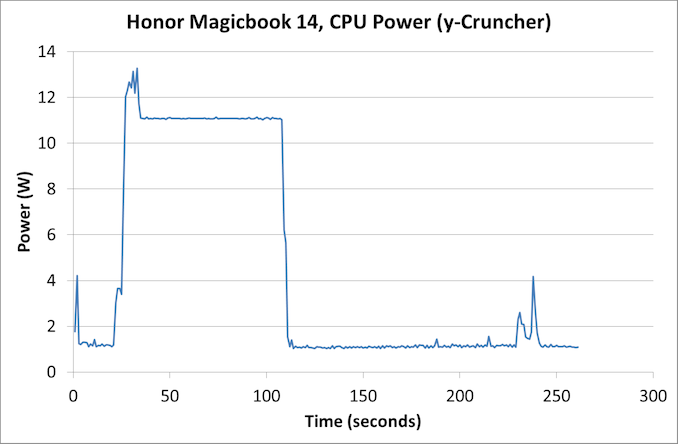
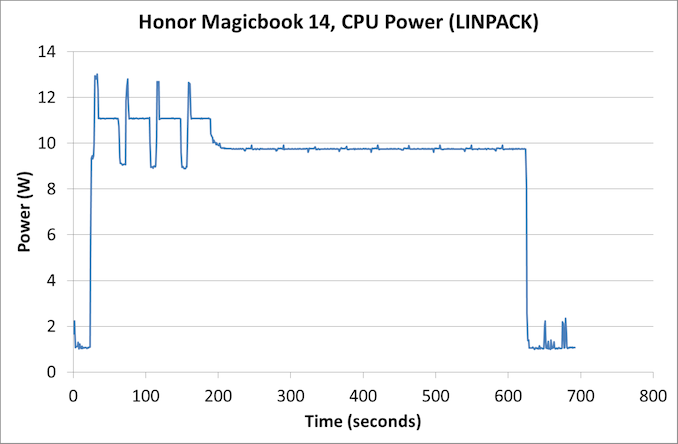
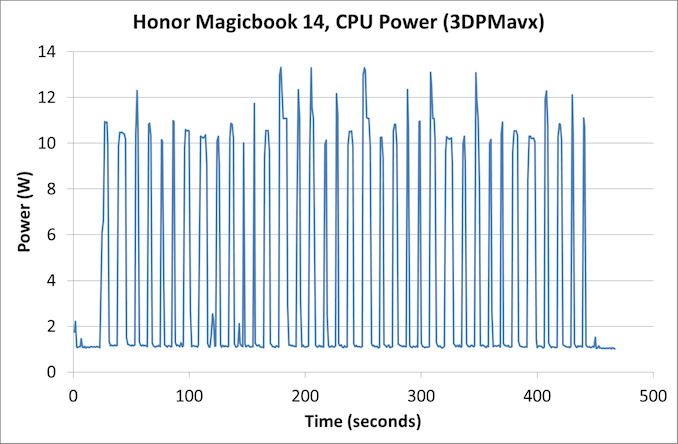
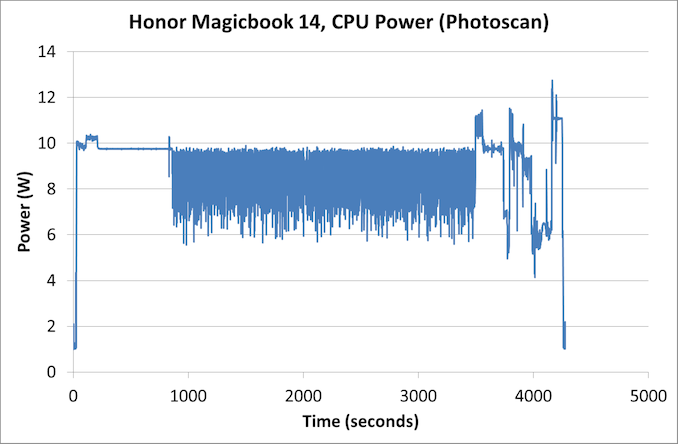

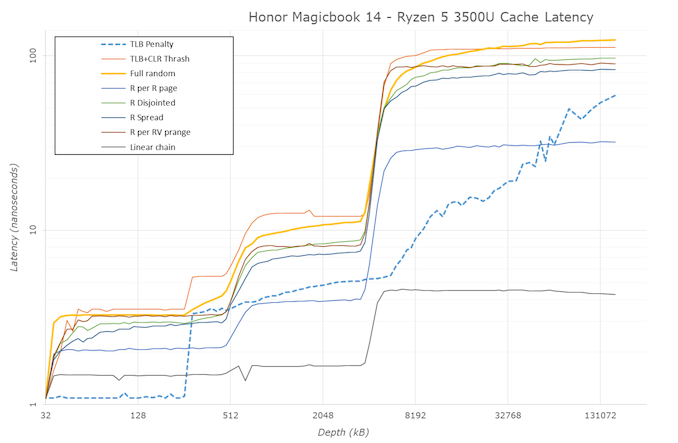








88 Comments
View All Comments
Jedibeeftrix - Friday, May 15, 2020 - link
"One of the best designs I ever had was the Huawei Matebook 13 (2017) model"Dear god, yes!
4800U / 16GB dual channel / 256GB nvme = sold
R3MF - Saturday, May 23, 2020 - link
Who knew!Huewieieiei have silently released an AMD flavoured Matebook 13 after all:
https://consumer.huawei.com/uk/laptops/matebook-13...
3500U, but here's hoping for a 4800U version...
nicolaim - Friday, May 15, 2020 - link
I don't want to complain too much about an inexpensive laptop, but that 16:9 LCD with the massive bezel underneath is just awful. The location of the webcam is a disaster. Lastly, 2020 is not the time to release a laptop with a bunch of USB-A ports...zentwo - Friday, May 15, 2020 - link
The bezel at the bottom is there so that the screen is not too low; also see the many complaints on the new Dell XPS 13 16:10 screen that got rid of that underneath bezel. And I use many USB-A devices in 2020. I agree with your opinion on the webcam location.jabber - Friday, May 15, 2020 - link
Yeah I'd rather have all USB A than anything else. Got no use for C right now or the forseeable future.bigboxes - Friday, May 15, 2020 - link
Maybe 5 years ago. Time for all type c. You get a dongle and the rest of get one cable.jabber - Saturday, May 16, 2020 - link
Dongles? Why, bother when I can plug my USB A drive straight in?Like folks that say these ultra slim laptops with like one port that are great cos you can plug them into these Thunderbolt dockers to get all the ports you need at your desk. Thing is back in the day you could plug a laptop into a docker and have the ports. Then if you unplugged it...the laptop still had most of those ports. Is this really going forward?
bigboxes - Sunday, May 17, 2020 - link
Type A ports need to go away. When there is no type A ports for you to connect your peripherals to you'll either need to purchase a dongle or new peripherals.Lord of the Bored - Sunday, May 17, 2020 - link
That is exactly why type-a ports DON'T need to go away. "Because the new connector is prettier" is a terrible reason to break compatibilty.RSAUser - Monday, May 18, 2020 - link
But why should I have to carry a dongle around? That seems backwards to me.Only USB peripherals I use are a mouse and keyboard, both USB type A, rest is display port monitors.